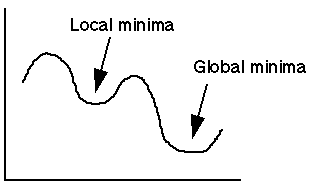Geometry Optimizations
- the process of determining the energy minima
- adjustment of bond angles and lengths that give the lowest possible energy value
If the bond length and angle of water are thought of as variables along the x and y axes and energy of that configuration is displayed along the z axis (height), then the three-dimensional surface which is created is called the "potential energy surface" for water. A portion of that surface is displayed below. A geometry optimization "walks" along this surface by making small changes in the geometry coordinates until it reaches (hopefully!) a basin.

- an iterative process that starts with a guessed geometry and ends up with an optimized geometry
- A successful optimization only guarantees a local minima, not a global minima. Repeated optimizations with other structures (conformers) must be conducted

Strategies
- use a semi-empirical level of theory (AM1) FIRST then re-optimize with ab initio (3-21G or 6-31G)
- one feature of a geometry is the symmetry of the molecule. If this property interferes with a successful optimization, turn it off
- nosymtry keyword (in option box)
- sometimes an optimization requires more cycles (iterations) than provided (250). If more are needed
[Previous][Next]
[CompChem Main Page][Contents]
[1]
[2]
[3]
[4]
[5]
[6]
[7]
[8]
[9]
[10]
[11]
[12]
[13]
[14]
[15]
[16]
[17]
[18]
[19]
[20]
[21]
[22]
[23]
[24]
[25]
[26]
[27]
[28]
[29]
[30]
[31]
[32]
[33]
[34]
Developed by
 The Shodor
Education Foundation, Inc.
The Shodor
Education Foundation, Inc.
Copyright © 1998
Last Modified:
Questions or comments about this page should be directed to gotwals@shodor.org



 The Shodor
Education Foundation, Inc.
The Shodor
Education Foundation, Inc.